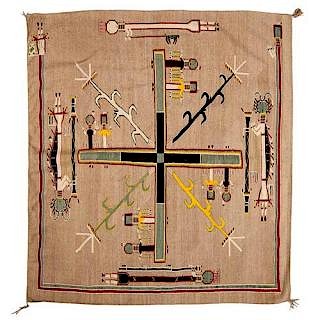Mrs. Sam (Gladys) Manuelito (Navajo, 1893-1987) Sandpainting Weaving Deaccessioned from the Hopewell Museum, Hopewell, NJ
About Seller
6270 Este Ave.
Cincinnati , OH 45232
United States
With offices in Cincinnati, Cleveland and Denver, Cowan’s holds over 40 auctions each year, with annual sales exceeding $16M. We reach buyers around the globe, and take pride in our reputation for integrity, customer service and great results. A full-service house, Cowan’s Auctions specializes in Am...Read more
Two ways to bid:
- Leave a max absentee bid and the platform will bid on your behalf up to your maximum bid during the live auction.
- Bid live during the auction and your bids will be submitted real-time to the auctioneer.
Bid Increments
| Price | Bid Increment |
|---|---|
| $0 | $25 |
| $500 | $50 |
| $1,000 | $100 |
| $2,000 | $250 |
| $5,000 | $500 |
| $10,000 | $1,000 |
| $20,000 | $2,500 |
| $50,000 | $5,000 |
| $100,000 | $10,000 |
About Auction
Sep 25, 2015 - Sep 26, 2015
Cowan's Auctions dawnie@cowans.com
- Lot Description
Mrs. Sam (Gladys) Manuelito (Navajo, 1893-1987) Sandpainting Weaving Deaccessioned from the Hopewell Museum, Hopewell, NJ
Chant: Nightway: A subgroup of God impersonators
Warp: Native handspun wool, 1-ply, 11 count to the inch
Weft: Native handspun wool, 1-ply, 46/48 count to the inch
5 ft. 7 in. x 5 ft. 5 in., Regional Period c. 1935 – 40
Navajo Chantway myths, briefly summarized, recount the trials and ordeals of a hero(es) or heroine(s) usually involving various monsters or physical change of form into other animals or personages. In each case they are rescued by the Gods and, after various purification rites and blessings, are taught the ceremony of the Chantway. They then return home to teach it to their people.
The major deities portrayed in this sandpainting are Talking God, head of the Gods, dressed in white buckskin and wearing a headdress of white eagle feathers. He is carrying a medicine pouch of an Abert’s squirrel pelt.
Opposite Talking God is Black Calling God who carries a black staff. The other two Gods are Humpback Gods which represent mountain sheep or big horn Gods. This God has a bag filled with fruit and black clouds with feathers attached representing sun beams. Other accouterments represent mist, sun rays, and rain. He is in effect a fertility symbol.
The arms of the swirling log represent the four cardinal points. The pairs of figures on them are male (round heads) and female (square heads) Yei, which are Holy People. The female’s chest is covered with yellow corn pollen. The four plants depicted are sacred corn representing the four cardinal points (white corn east, blue corn south, black corn north, yellow corn west).
According to Wyman, the diseases cured with this ceremony include head ailments, blindness, insanity, crippling, paralysis, and headaches.
Mrs. Sam (Gladys) Manuelito, 1893–1987, was the niece of the famous Navajo medicine man and weaver Hosteen Klah who encouraged her to weave sandpaintings and taught her the correct imagery. Her work is represented in numerous museum collections.
-Tyrone Campbell
Scottsdale, AZ
March 2015
Dr. David Blackwell Hill (1887-1979)
Dr. Hill purchased American Indian art long before it was fashionable, in fact long before there were books written to educate the public about the beautiful objects America’s first peoples made. We can only speculate about how Dr. Hill knew to purchase some of the best of the best. Perhaps, as a Manhattanite, he saw the successful 1931 Exposition of Indian Tribal Arts at the Grand Central Art Gallery in New York City. This was the first exhibit designed specifically to show Indian cultural material (pottery, weavings, beadwork, etc.) as “Art.” Amelia Elizabeth White was one of the organizers of this watershed exposition and, at that time, already owned an Indian shop, Ishauu, later named the Gallery of American Indian Art, on Madison Avenue. One wonders if some of the items might have come from her store.
Hill was born in Hopewell, Mercer Co., NJ. After graduating from medical school in 1910, he married Janet A. Hurd and worked as a physician in New York City until 1952. The Hills resided on the Upper West Side, later moving to the Upper East Side. Upon Hill’s retirement the couple moved to Altadena, CA, where Hill died on May 9, 1979. Hill gave his American Indian art collection to the Hopewell Museum in 1966.
Provenance: Deaccessioned From the Hopewell Museum, Hopewell, NJ; Collected and Donated by Dr. David B. Hill (1887-1979)Included is the write-up and certification by Tyrone Campbell.Condition
Condition requests can be obtained via email (danica@cowans.com) or by telephone (513-871-1670). Any condition statement given, as a courtesy to a client, is only an opinion and should not be treated as a statement of fact. Cowan's Auctions shall have no responsibility for any error or omission. - Shipping Info
-
SHIPPING. At the request of the buyer, Cowan's will authorize the shipment of purchased items. Shipments usually occur within two weeks after payment has been received. Shipment is generally made via UPS Ground service. Unless buyer gives special instructions, the shipping method shall be at the sole discretion of Cowan's Auctions, Inc.. Cowan's is in no way responsible for the acts or omissions of independent handlers, packers or shippers of purchased items or for any loss, damage or delay from the packing or shipping of any property.
-
- Buyer's Premium



 EUR
EUR CAD
CAD AUD
AUD GBP
GBP MXN
MXN HKD
HKD CNY
CNY MYR
MYR SEK
SEK SGD
SGD CHF
CHF THB
THB











